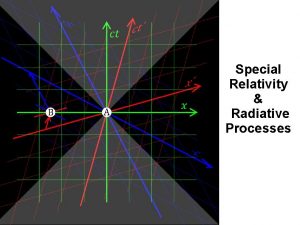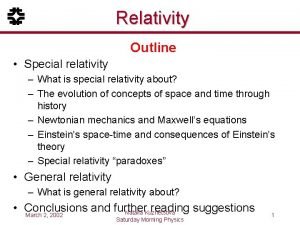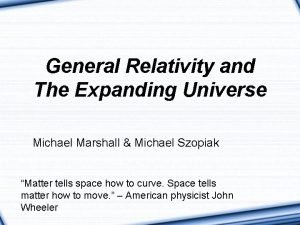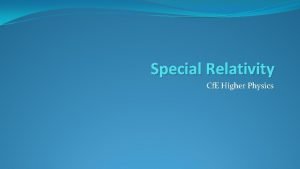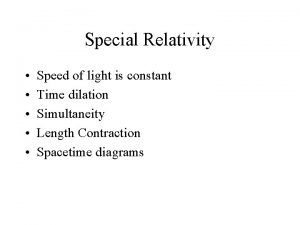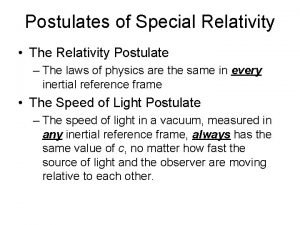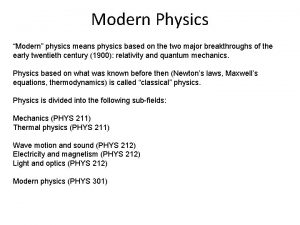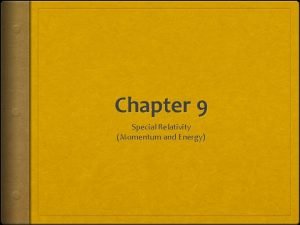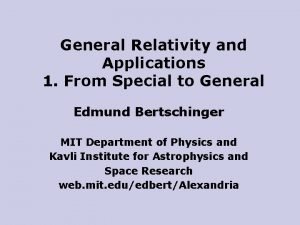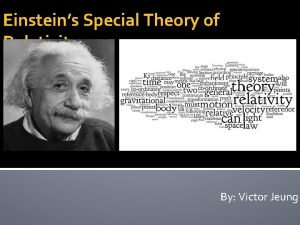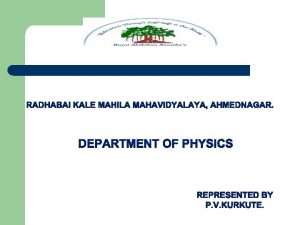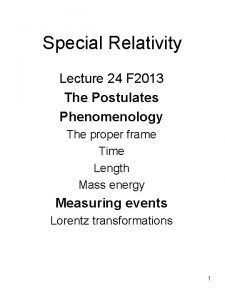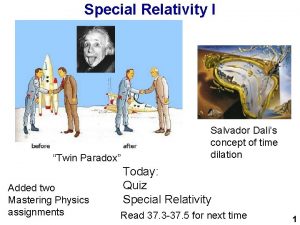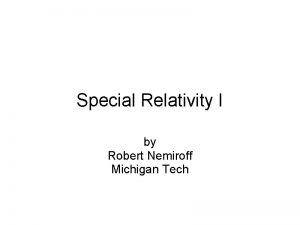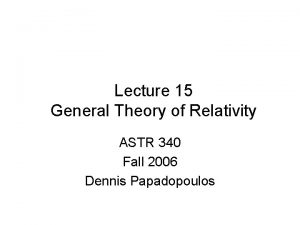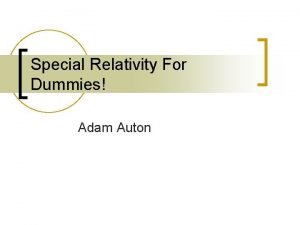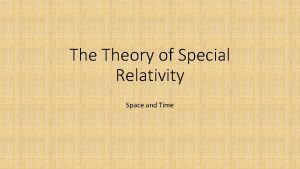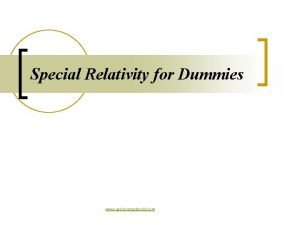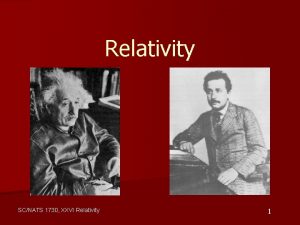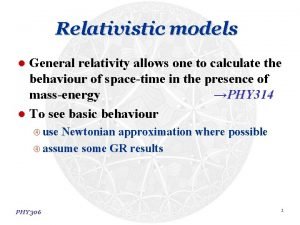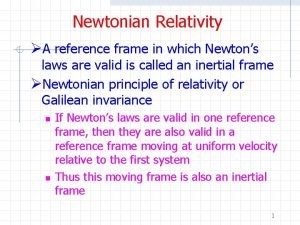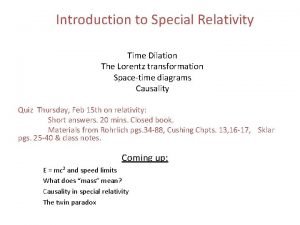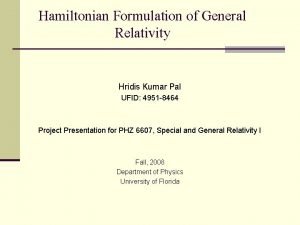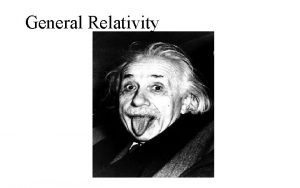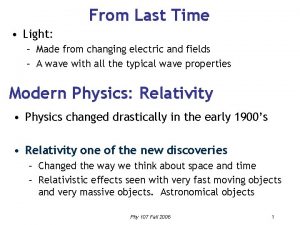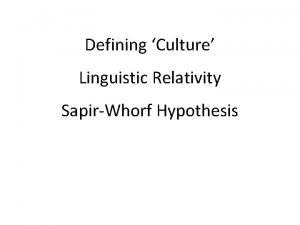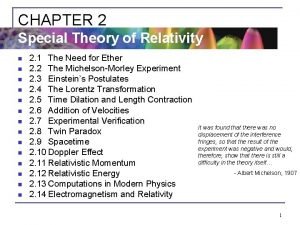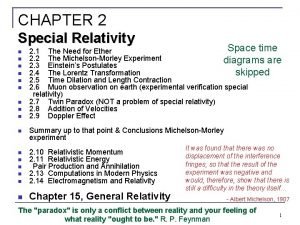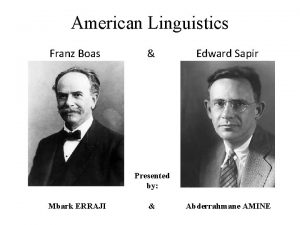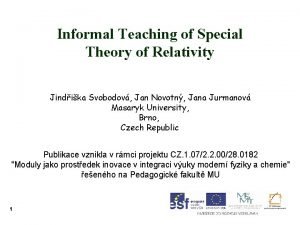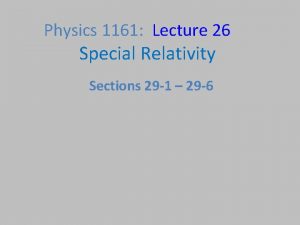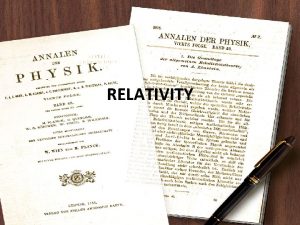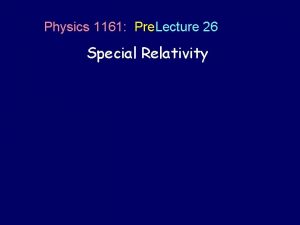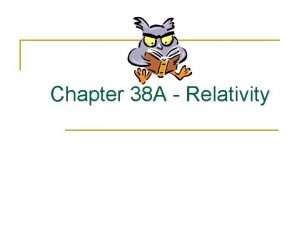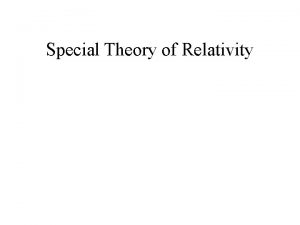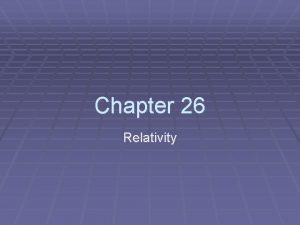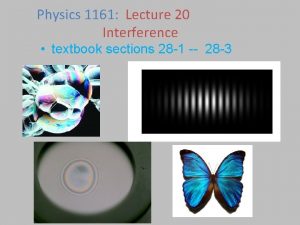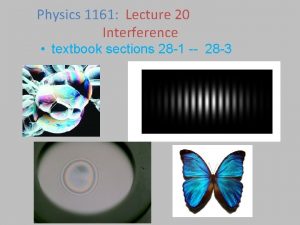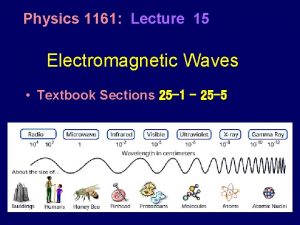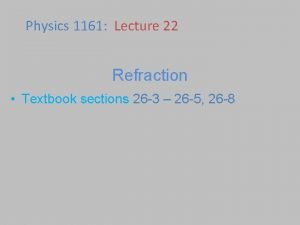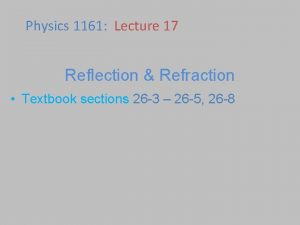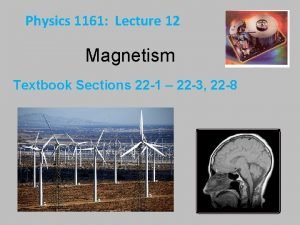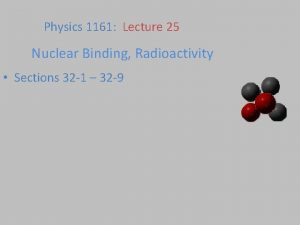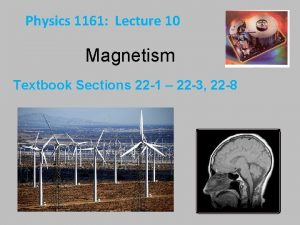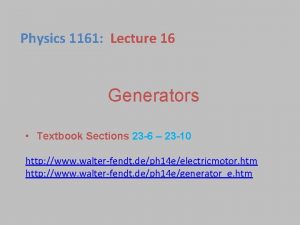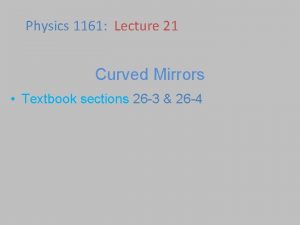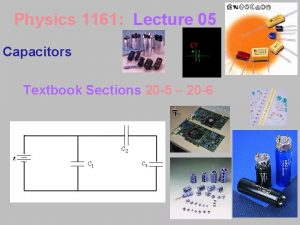Physics 1161 Lecture 35 Special Relativity Sections 29









































- Slides: 41

Physics 1161: Lecture 35 Special Relativity Sections 29 -1 – 29 -6

Special Relativity

• Null result of Michelson Morley Experiment • Relative motion of magnet and loop of wire induces current in loop • http: //www. fourmilab. ch/etexts/einstein/spe crel/www/

Michelson-Morley Experiment. Null Resu In te r et fe ro m • Designed to prove the existence of the ether – the still reference frame • Speed of light was the same no matter the direction relative to the earth’s motion er lt

You and your friend are playing catch in a train moving at 60 mph in an eastward direction. Your friend is at the front of the car and throws you the ball at 3 mph (according to you). What velocity does the ball have when you catch it, according to you? 1) 2) 3) 4) 5) 3 mph eastward 3 mph westward 57 mph eastward 57 mph westward 60 mph eastward

You and your friend are playing catch in a train moving at 60 mph in an eastward direction. Your friend is at the front of the car and throws you the ball at 3 mph (according to you). What velocity does the ball have when you catch it, according to you? 1) 2) 3) 4) 5) 3 mph eastward 3 mph westward 57 mph eastward 57 mph westward 60 mph eastward

You and your friend are playing catch in a train moving at 60 mph in an eastward direction. Your friend is at the front of the car and throws you the ball at 3 mph (according to you). What velocity does the ball have as measured by someone at rest on the platform? 1) 2) 3) 4) 5) 63 mph eastward 63 mph westward 57 mph eastward 57 mph westward 60 mph eastward

You and your friend are playing catch in a train moving at 60 mph in an eastward direction. Your friend is at the front of the car and throws you the ball at 3 mph (according to you). What velocity does the ball have as measured by someone at rest on the platform? 1) 2) 3) 4) 5) 63 mph eastward 63 mph westward 57 mph eastward 57 mph westward 60 mph eastward

Inertial Reference Frame • Frame in which Newton’s Laws Work • Moving is OK but…. – No Accelerating – No Rotating • Technically Earth is not inertial, but it’s close enough.

Which of the following systems are not inertial reference frames? 1) a person standing still 2) an airplane in mid-flight 3) a merry-go-round rotating at a constant rate 4) all of the above are IRFs 5) none of the above are IRFs

Which of the following systems are not inertial reference frames? 1) a person standing still 2) an airplane in mid-flight 3) a merry-go-round rotating at a constant rate 4) all of the above are IRFs 5) none of the above are IRFs An inertial reference frame is the same as a non-accelerating reference frame Due to the circular motion of the merry-go-round, there is a centripetal acceleration, acceleration which means that the system is accelerating. Therefore it is not an inertial reference frame.

Special Theory of Relativity Postulates • All laws of nature are the same in all uniformly moving frames of reference. • The speed of light in free space has the same measured value for all observers, regardless of the motion of the source or the motion of the observer; that is, The speed of a light flash the speed of light is a constant. emitted by the space station is measured to be c by observers on both the space station and the rocket ship.

Which of these quantities change when you change your reference frame? 1) 2) 3) 4) 5) position velocity acceleration All of the above Only a) and b)

Which of these quantities change when you change your reference frame? 1) position 2) velocity 3) acceleration 4) All of the above 5) Only a) and b) Position depends on your reference frame – it also depends on your coordinate system. Velocity depends on the difference in position, which also relates to the frame of reference. However, since acceleration relates to the difference in velocity, this will actually be the same in all reference frames.

Simultaneity • two events are simultaneous if they occur at the same time. From the point of view of the observer who travels with the compartment, light from the source travels equal distances to both ends of the compartment and therefore strikes both ends simultaneously.

Simultaneity • http: //sq. netlog. com/go/explore/videos/vide oid=sq-18174

Simultaneity • Two events that are simultaneous in one frame of reference need not be simultaneous in a frame moving relative to the first frame. Because of the ship's motion, light that strikes the back of the compartment doesn't have as far to go and strikes sooner than light strikes the front of the compartment.

A boxcar moves to the right at a very high speed. A green flash of light moves from right to left, and a blue flash from left to right. For someone with sophisticated measuring equipment in the boxcar, which flash takes longer to go from one end to the other? 1) the blue flash 2) the green flash 3) both the same v

A boxcar moves to the right at a very high speed. A green flash of light moves from right to left, and a blue flash from left to right. For someone with sophisticated measuring equipment in the boxcar, which flash takes longer to go from one end to the other? 1) the blue flash 2) the green flash 3) both the same v The speed of light is c inside the boxcar, and the distance that each flash must travel is L (length of boxcar). So each flash will take t = L/c, which will be the same for each one.

A boxcar moves to the right at a very high speed. A green flash of light moves from right to left, and a blue flash from left to right. According to an observer on the ground, which flash takes longer to go from one end to the other? 1) the blue flash 2) the green flash 3) both the same v

A boxcar moves to the right at a very high speed. A green flash of light moves from right to left, and a blue flash from left to right. According to an observer on the ground, which flash takes longer to go from one end to the other? 1) the blue flash 2) the green flash v 3) both the same The ground observer still sees the light moving at speed c. But while the light is going, the boxcar has actually advanced The back wall is moving toward the green flash, and the front wall is moving away from the blue flash. Thus, the blue flash has a longer distance to travel and takes a longer time

Time Dilation • http: //www. youtube. com/watch? v=KHjp. Bjg. I MVk&feature=related

Time Dilation D t 0 is proper time Because it is rest frame of event

Time Dilation D L=v Dt D ½ v. Dt t 0 is proper time Because it is rest frame of event

An astronaut moves away from Earth at close to the speed of light. How would an observer on Earth measure the astronaut’s pulse rate? 1) 2) 3) 4) it would be faster it would be slower it wouldn’t change no pulse - the astronaut died a long time ago

An astronaut moves away from Earth at close to the speed of light. How would an observer on Earth measure the astronaut’s pulse rate? 1) 2) 3) 4) it would be faster it would be slower it wouldn’t change no pulse - the astronaut died a long time ago The astronaut’s pulse would function like a clock. Since time moves slower in a moving reference frame, the observer on Earth would measure a slower pulse.

The period of a pendulum attached in a spaceship is 2 seconds while the spaceship is parked on Earth. What is its period for an observer on Earth when the spaceship moves at 0. 6 c with respect to Earth? 1) Less than 2 seconds 2) 2 seconds 3) More than 2 seconds

The period of a pendulum attached in a spaceship is 2 seconds while the spaceship is parked on Earth. What is its period for an observer on Earth when the spaceship moves at 0. 6 c with respect to Earth? 1) Less than 2 seconds 2) 2 seconds 3) More than 2 seconds To the Earth observer, the pendulum is moving relative to him and so it takes longer to swing (moving clocks run slow) due to the effect of time dilation.

The period of a pendulum attached in a spaceship is 2 seconds while the spaceship is parked on Earth. What would the astronaut in the spaceship measure the period to be? 1) Less than 2 seconds 2) 2 seconds 3) More than 2 seconds

The period of a pendulum attached in a spaceship is 2 seconds while the spaceship is parked on Earth. What would the astronaut in the spaceship measure the period to be? 1) Less than 2 seconds 2) 2 seconds 3) More than 2 seconds

Space Travel Alpha Centauri is 4. 3 light-years from earth. (It takes light 4. 3 years to travel from earth to Alpha Centauri). How long would people on earth think it takes for a spaceship traveling v=0. 95 c to reach A. C. ? How long do people on the ship think it takes?

Space Travel Alpha Centauri is 4. 3 light-years from earth. (It takes light 4. 3 years to travel from earth to Alpha Centauri). How long would people on earth think it takes for a spaceship traveling v=0. 95 c to reach A. C. ? How long do people on the ship think it takes? People on ship have ‘proper’ time they see earth leave, and Alpha Centauri arrive. Dt 0 Physics 1161: Lecture 28, Slide 32 Dt 0 = 1. 4 years

Length Contraction People on ship and on earth agree on relative velocity v = 0. 95 c. But they disagree on the time (4. 5 vs 1. 4 years). What about the distance between the planets? Earth/Alpha d 0 = v t Ship d=vt Length in moving frame Length in object’s rest frame

Length Contraction Sue is carrying a pole 10 meters long. Paul is on a barn which is 8 meters long. If Sue runs quickly v=. 8 c, can she ever have the entire pole in the barn? Paul: Sue:

Length Contraction People on ship and on earth agree on relative velocity v = 0. 95 c. But they disagree on the time (4. 5 vs 1. 4 years). What about the distance between the planets? Earth/Alpha d 0 = v t =. 95 (3 x 108 m/s) (4. 5 years) = 4 x 1016 m Ship d=vt (4. 3 light years) =. 95 (3 x 108 m/s) (1. 4 years) = 1. 25 x 1016 m (1. 3 light years) Length in moving frame Length in object’s rest Physics 1161: Lecture 28, Slide frame 35

Length Contraction Gifs v=0. 1 c v=0. 8 c v=0. 95 c

Your spaceship is parked outside an interstellar cafe. A speeder zooms by in an identical ship traveling at half the speed of light. From your perspective, their ship looks: 1) Longer than your ship 2) Shorter than your ship 3) Exactly the same as your ship

Your spaceship is parked outside an interstellar cafe. A speeder zooms by in an identical ship traveling at half the speed of light. From your perspective, their ship looks: 1) Longer than your ship 2) Shorter than your ship 3) Exactly the same as your ship In the speeder’s reference frame Lo > L In your reference frame Always <1

Comparison: Time Dilation vs. Length Contraction • Dto = time in same reference frame as event – i. e. if event is clock ticking, then Dto is in the reference frame of the clock (even if the clock is in a moving spaceship). Dt > Dto Time seems longer from “outside” • Lo = length in same reference frame as object – length of the object when you don’t think it’s moving. Lo > L Length seems shorter from “outside”

Relativistic Momentum Note: for v<<c p=mv Note: for v=c p=infinity Relativistic Energy Note: for v=0 E = mc 2 Note: for v<<c E = mc 2 + ½ mv 2 Note: for v=c E = infinity (if m<> 0) Objects with mass can’t go faster than c!

Summary • Physics works in any inertial frame – Simultaneous depends on frame • Proper frame is where event is at same place, or object is not moving. – Time dilates – Length contracts – Energy/Momentum conserved • For v<<c reduce to Newton’s Laws
 Special relativity vs general relativity
Special relativity vs general relativity Special vs general relativity
Special vs general relativity Special vs general relativity
Special vs general relativity Mythbusters relative velocity
Mythbusters relative velocity Special relativity
Special relativity Postulates of special theory of relativity
Postulates of special theory of relativity Special relativity postulates
Special relativity postulates Modern physics meaning
Modern physics meaning Momentum special relativity
Momentum special relativity Special relativity summary
Special relativity summary Albert einstein theory of special relativity
Albert einstein theory of special relativity Postulates of special theory of relativity
Postulates of special theory of relativity Postulates of special theory of relativity
Postulates of special theory of relativity Albert einstein twin paradox
Albert einstein twin paradox Special relativity
Special relativity Special theory of relativity
Special theory of relativity Adam auton
Adam auton 01:640:244 lecture notes - lecture 15: plat, idah, farad
01:640:244 lecture notes - lecture 15: plat, idah, farad Physics 111 lecture notes
Physics 111 lecture notes Physics 101 lecture
Physics 101 lecture Physics 101 lecture 1
Physics 101 lecture 1 Physics 101 lecture notes pdf
Physics 101 lecture notes pdf Wave motion definition
Wave motion definition Atmospheric physics lecture notes
Atmospheric physics lecture notes Time dilation theory of relativity
Time dilation theory of relativity Linguistic relativity definition
Linguistic relativity definition Relativity for dummies
Relativity for dummies Einstein thought experiment elevator
Einstein thought experiment elevator Relativistic acceleration calculator
Relativistic acceleration calculator Sapir whorf hypothesis
Sapir whorf hypothesis Teoria de la relatividad newton
Teoria de la relatividad newton The law of relativity
The law of relativity Hridis kumar pal
Hridis kumar pal Relativity
Relativity Galilean relativity
Galilean relativity Interstellar time dilation
Interstellar time dilation Sapir whorf theory
Sapir whorf theory Lorentz transformation equation
Lorentz transformation equation Relativity
Relativity Definition of linguistic determinism
Definition of linguistic determinism Careershodh
Careershodh Theory of relativity cartoon
Theory of relativity cartoon
